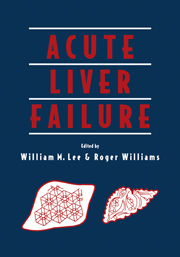Book contents
- Frontmatter
- Contents
- Preface
- Foreword
- Acknowledgments
- Contributors
- Part One Clinical Syndrome and Etiology
- Part Two Mechanisms of Disease and Multisystem Involvement
- Part Three Intensive Care Management
- Part Four Transplantation
- Part Five Artificial and Bioartificial Liver Devices
- 18 Extracorporeal liver support: historical background and critical analysis
- 19 Hepatocyte culture and bioreactor design for liver support systems
- 20 Clinical experience with an extracorporeal liver assist device
- Part Six Other Applications
- Index
- Plate section
18 - Extracorporeal liver support: historical background and critical analysis
from Part Five - Artificial and Bioartificial Liver Devices
Published online by Cambridge University Press: 20 May 2010
- Frontmatter
- Contents
- Preface
- Foreword
- Acknowledgments
- Contributors
- Part One Clinical Syndrome and Etiology
- Part Two Mechanisms of Disease and Multisystem Involvement
- Part Three Intensive Care Management
- Part Four Transplantation
- Part Five Artificial and Bioartificial Liver Devices
- 18 Extracorporeal liver support: historical background and critical analysis
- 19 Hepatocyte culture and bioreactor design for liver support systems
- 20 Clinical experience with an extracorporeal liver assist device
- Part Six Other Applications
- Index
- Plate section
Summary
INTRODUCTION
Acute liver failure (ALF), the rapid development of severely deranged and relentlessly worsening liver function in the previously healthy individual, progressing to encephalopathy, coma and death, is the most dramatic illness with which the hepatologist is confronted. Historically, the condition seemed uncommon, and most reports in the literature before 1960 described isolated cases or, at most, small series of a few patients (Benhamou et al. 1972). The first systematic effort to accumulate data on a larger experience was the National Fulminant Hepatic Failure Study, stimulated by an apparent ALF epidemic associated with the use of halothane anesthesia, in which investigators assembled data on a large number of cases from multiple institutions (Trey and Davidson 1970). The interest that followed this study, the wave of cases caused by the growing popularity of acetaminophen (paracetamol) overdose as a means of attempting suicide, and the availability of experimental therapeutic technologies led, starting in the 1970s, to the establishment of specialized liver failure units. These units, at first principally in the United Kingdom and in France, developed experience in the care of large numbers of cases. They thus provided the first opportunity to assess new, experimental therapies in significant numbers of patients, and indeed, stimulated the development of successive waves of new therapies. The United States initially lagged in this effort. However, the role of liver transplantation in the treatment of ALF has led increasingly to the referral of such cases to centers which could offer transplantation as a treatment of last resort.
- Type
- Chapter
- Information
- Acute Liver Failure , pp. 223 - 244Publisher: Cambridge University PressPrint publication year: 1996



